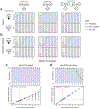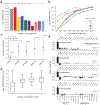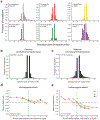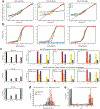Patterns of de novo tandem repeat mutations and their role in autism
- PMID: 33442040
- PMCID: PMC7810352
- DOI: 10.1038/s41586-020-03078-7
Patterns of de novo tandem repeat mutations and their role in autism
Abstract
Autism spectrum disorder (ASD) is an early-onset developmental disorder characterized by deficits in communication and social interaction and restrictive or repetitive behaviours1,2. Family studies demonstrate that ASD has a substantial genetic basis with contributions both from inherited and de novo variants3,4. It has been estimated that de novo mutations may contribute to 30% of all simplex cases, in which only a single child is affected per family5. Tandem repeats (TRs), defined here as sequences of 1 to 20 base pairs in size repeated consecutively, comprise one of the major sources of de novo mutations in humans6. TR expansions are implicated in dozens of neurological and psychiatric disorders7. Yet, de novo TR mutations have not been characterized on a genome-wide scale, and their contribution to ASD remains unexplored. Here we develop new bioinformatics methods for identifying and prioritizing de novo TR mutations from sequencing data and perform a genome-wide characterization of de novo TR mutations in ASD-affected probands and unaffected siblings. We infer specific mutation events and their precise changes in repeat number, and primarily focus on more prevalent stepwise copy number changes rather than large expansions. Our results demonstrate a significant genome-wide excess of TR mutations in ASD probands. Mutations in probands tend to be larger, enriched in fetal brain regulatory regions, and are predicted to be more evolutionarily deleterious. Overall, our results highlight the importance of considering repeat variants in future studies of de novo mutations.
Figures














Comment in
-
Repeat DNA expands our understanding of autism spectrum disorder.Nature. 2021 Jan;589(7841):200-202. doi: 10.1038/d41586-020-03658-7. Nature. 2021. PMID: 33442037 No abstract available.
-
Linking newly occurring mutations to autism.Nat Rev Genet. 2021 Mar;22(3):133. doi: 10.1038/s41576-021-00335-x. Nat Rev Genet. 2021. PMID: 33542502 No abstract available.
Similar articles
-
Rare Inherited and De Novo CNVs Reveal Complex Contributions to ASD Risk in Multiplex Families.Am J Hum Genet. 2016 Sep 1;99(3):540-554. doi: 10.1016/j.ajhg.2016.06.036. Epub 2016 Aug 25. Am J Hum Genet. 2016. PMID: 27569545 Free PMC article.
-
De novo structural mutation rates and gamete-of-origin biases revealed through genome sequencing of 2,396 families.Am J Hum Genet. 2021 Apr 1;108(4):597-607. doi: 10.1016/j.ajhg.2021.02.012. Epub 2021 Mar 5. Am J Hum Genet. 2021. PMID: 33675682 Free PMC article.
-
Identification of de novo Mutations in the Chinese Autism Spectrum Disorder Cohort via Whole-Exome Sequencing Unveils Brain Regions Implicated in Autism.Neurosci Bull. 2023 Oct;39(10):1469-1480. doi: 10.1007/s12264-023-01037-6. Epub 2023 Mar 7. Neurosci Bull. 2023. PMID: 36881370 Free PMC article.
-
Autism Spectrum Disorder: Genetic Mechanisms and Inheritance Patterns.Genes (Basel). 2025 Apr 23;16(5):478. doi: 10.3390/genes16050478. Genes (Basel). 2025. PMID: 40428300 Free PMC article. Review.
-
Somatic Mosaicism and Autism Spectrum Disorder.Genes (Basel). 2021 Oct 26;12(11):1699. doi: 10.3390/genes12111699. Genes (Basel). 2021. PMID: 34828306 Free PMC article. Review.
Cited by
-
A de novo ARIH2 gene mutation was detected in a patient with autism spectrum disorders and intellectual disability.Sci Rep. 2024 Jul 9;14(1):15848. doi: 10.1038/s41598-024-66475-2. Sci Rep. 2024. PMID: 38982159 Free PMC article.
-
Integrating whole-genome sequencing with multi-omic data reveals the impact of structural variants on gene regulation in the human brain.Nat Neurosci. 2022 Apr;25(4):504-514. doi: 10.1038/s41593-022-01031-7. Epub 2022 Mar 14. Nat Neurosci. 2022. PMID: 35288716 Free PMC article.
-
Genetic and chemotherapeutic influences on germline hypermutation.Nature. 2022 May;605(7910):503-508. doi: 10.1038/s41586-022-04712-2. Epub 2022 May 11. Nature. 2022. PMID: 35545669 Free PMC article.
-
Profiling the Genome-Wide Landscape of Short Tandem Repeats by Long-Read Sequencing.Front Genet. 2022 May 5;13:810595. doi: 10.3389/fgene.2022.810595. eCollection 2022. Front Genet. 2022. PMID: 35601492 Free PMC article.
-
FAN1, a DNA Repair Nuclease, as a Modifier of Repeat Expansion Disorders.J Huntingtons Dis. 2021;10(1):95-122. doi: 10.3233/JHD-200448. J Huntingtons Dis. 2021. PMID: 33579867 Free PMC article. Review.
References
Main References
-
- Association, A. P. Diagnostic and Statistical Manual of Mental Disorders (DSM-5®). (American Psychiatric Pub, 2013).
Methods References
-
- Li H Aligning sequence reads, clone sequences and assembly contigs with BWA-MEM. arXiv: Genomics (2013).
Publication types
MeSH terms
Grants and funding
LinkOut - more resources
Full Text Sources
Other Literature Sources
Medical

